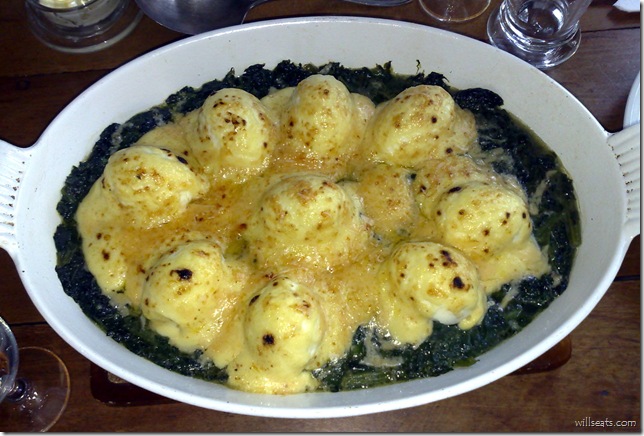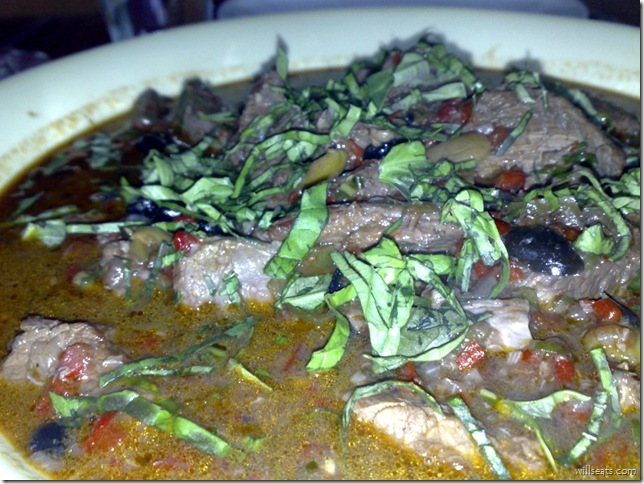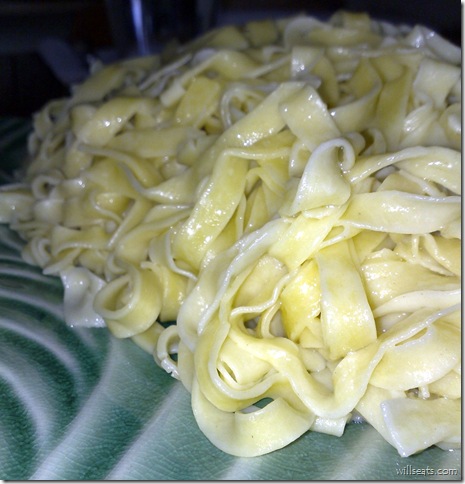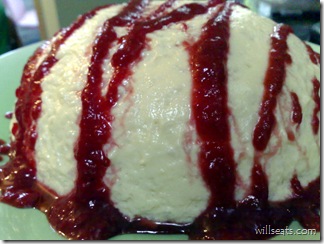Veal Fricassee et al : Lesson 12 : LCB at Home
The dinner was:
Oeufs Mollets Florentine : Soft-Boiled Eggs with Spinach and Mornay Sauce
Better known as "Eggs Florentine". Simple enough but we deviated from the recipe (the book: Le Cordon Bleu: At Home) because the spinach they have in France must be different than what we get here in Canada. Here it is evidently more tender so boiling it to death, as called for in the book, would be overdoing it. A bit of a steam in its own moisture was enough to do the base of spinach. Note: Wring out the spinach well to avoid pooling liquid in the bottom of the dish.
The "recipe" for soft boiled eggs didn't work as expected.; they were not soft enough for a European palate - - not runny at all. The book calls for putting the eggs in cold water then back to a boil and then simmer for 5 minutes; a simmer for three (3) would have been better I think.
The Mornay Sauce on top was a old favorite from Choux Puffs : Lesson 7. Then it's under the broiled briefly to color them up a little bit. This is an excellent dish.
Fricassée de Veau aux Poivrons Rogues : Fricassee of Veal with Sweet Peppers, Tomatoes, and Olives
Ah, the veal. Again with the Veal Shoulder; apparently a versatile meat - and inexpensive too boot.
Better known as "Veal Fricassee". That's basil on top of it; a pleasant variant of the usual decorative parsley; and there's some in the dish as well . The directions always say to make "2 inch cubes" of meat [5 cm] and I can never bring myself to make chunks that huge - - but this time I tried. They probably came out mostly at an inch and a half [1 1/2"; 3,5cm] so I'm working my way up towards the "proper" size. The suspicion is that the meat-chunk size affects the cooking process so it might turn out to be important.
Also made the Fond de Veau Brun : Brown Veal Stock in preparation for this dish. The butcher had no veal bones so regular beef bones were used - which seemed to work out okay. Went by the recipe (well, a 1/3 sized recipe) but would have been better off browning the bones at 400 F instead of 500 F (it got a bit smoky there for a while). Another book has you put the veggies in to brown as well and that is, as I recall, how we did in class - the bones on a bed of veggies. A longer simmering time for the stock, up to 5-6 hours, wouldn't hurt either.
As for the Fricassee... the color is a bit pink hued in the meat because of the red peppers in the sauce so that gives an interesting look to the dish. It also has black and green olives (pitted) and, as I mentioned, basil in it; an unusual combination.
I chopped the onion, green pepper, tomato, and red pepper up in fine brunoise [dice] in my best "professional" fashion. Very tiny so that they'd become nearly invisible in the sauce and therefore less easily discoverable by certain, young, very particular [picky] eaters - - seems to have worked.
And… I cooked the meat for the full length of time recommended in the recipe since I had come close to cutting the pieces to the proper size: the meat came out quite fine, than you. I shall mention too that I did not fanatically trim all the silverskin from the meat. I removed anything that might be gristley or unpleasant but was much less fanatic about taking off every little bit of non-red stuff - - in expectation that it would all reduce or dissolve with the new, longer, cooking time. The plan seems to have worked. The meat was very good, tender, and had no tough bits remaining by the time the cooking was all done.
Pâtes Fraîches : Fresh Pasta
The first time I ever made fresh pasta at home; although I'd done it in school in Paris. Used the Kitchenaide to mix the ingredients, kneaded by hand and used a hand-crank machine to squish and cut the noodles. It all worked quite well. Advice: use liberal amounts of flour on the surfaces of the machine to prevent sticking when rolling and cutting; get help "catching" the pasta as it come out the bottom of the machine; dust it well with flour when drying; and, finally, string up some kitchen twine or something as a clothesline to hang the noodles on to dry - much more effective than lying it out on kitchen towels I think. If using kitchen otwels to dry the pasta you'll need at least two (2) towels. I started with one and it quickly filled up (do not overlap fresh noodle layers).
This pic is just the pasta tossed, as recommended, with some butter (and a bit of oil).
Riz à l’Impératrice : Empress Rice Pudding
Take a Bavarian Creme and add rice cooked partially in milk. Spout, in this case, berry sauce over it (leftover from last week - no need to make the glaze specified in the book).
This does not make great leftovers; the rice gets somewhat gelatinous the second day.
That's it. The whole deal in one go.






No comments:
Post a Comment